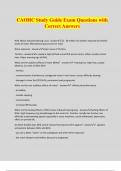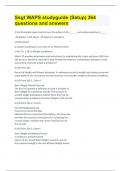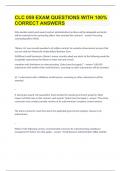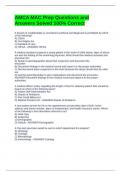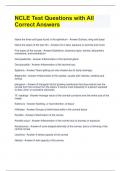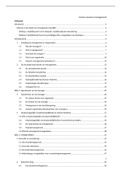Communication in everyday life
Chapter 05 – Nonverbal communication
Nonverbal communication is any symbolic activity that communicates a message other than words:
Facial expression, hand movements, dress, tattoos, jewellery, physical attractiveness, timing of what
happens, distance, tone of voice, eye movements, the positioning of furniture to create atmosphere,
touch, and smell. Nonverbal communication is used differently by different cultures. In deaf cultures:
substitute to speech and has its own complex signs and codes. In Mediterranean cultures: it is used as
a perpetual accompaniment of speech with much arm and hand movement as well as facial
expressions changing for emphasis and clarity.
Nonverbal communication is always present during face-to-face interactions and carries messages
over and above the words you speak. It may go along with verbal communication, but not always.
Nonverbal communication frames talk and assists in determining its meaning. Nonverbal
communication can also frame other people’s assessments and judgements of you and your identity,
your status and power, and your sincerity in what you say. It conveys something about your sense of
relaxation and comfort with the person with whom you are speaking and also indicates your
evaluation or assessment of that person. Nonverbal communication is an essential relational element
of all interaction, and you cannot have interactions without nonverbal communication.
Difficulties arise when there are no nonverbal cues such as when texting or sending an email.
Nonverbal communication may also increase effectiveness in interpreting the messages of others and
conveying your own messages.
What is nonverbal communication?
Both verbal and nonverbal communication are symbolic and share many of the same characteristics,
such as being personal, ambiguous, guided by rules, and linked to culture. Characteristics unique to
nonverbal communication are its continuous nature and that it is often beyond our control.
SYMBOLIC
Nonverbal and verbal communication are both symbolic. Verbal communication involves the use
words and nonverbal communication involves every other symbolic activity.
DECODING AND ENCODING
Decoding is the act of assigning meaning to nonverbal symbols. When decoding a message, you draw
meaning from something you observe.
Effective decoding increases the chances of accurately assigning meaning to the messages of others.
It will also enable you to determine a person’s emotions.
Characteristics of effective decoding
Effective decoders attend to whether other pay attention to nonverbal communication and seem to
understand it. A skilled decoder will determine whether the person with whom he or she is
interacting seems to pick up on nonverbal cues being provided.
Effective decoders bond with others and watch for signals others send about comfort in their
situation. A skilled decoder will notice when a speaker is anxious and will smile more often or reward
the speaker with head nods and encouraging nonverbal communication to put him or her at ease.
, Effective decoders coordinate with others and respond to cues so the interaction runs smoothly with
no awkward silences.
Effective decoders detect the undercurrents of a speaker’s talk by attending carefully to eye
movements and gestures that “leak” what the speaker truly feels.
Encoding is the act of using nonverbal symbols to convey meaning. When encoding a nonverbal
message, you put your feelings or other information into your messages. It will enable you to put
your feelings “out there” and help other people to “get” what is going on inside you when so desired.
Characteristics of effective encoding
Effective encoders affirm through encoding approval and liking while talking. Examples of this
behaviour include smiling and maintaining eye contact.
Effective encoders blend their nonverbal communication with their verbal communication to allow for
consistency between what is spoken and what is conveyed nonverbally.
Effective encoders are direct by striving to make their nonverbal communication clear and as
unambiguous as possible.
Effective encoders exhibit emotional clarity so that the emotions of their words are matched by their
nonverbal expression of emotion.
DYNAMIC AND STATIC
Nonverbal communication can be both dynamic and static. Dynamic nonverbal communication is that
which is changeable during an interaction. Examples for nonverbal communication include eye
contact, facial expression, voice and gestures. As you talk with someone, your eye contact will vary,
your facial expressions will change, elements of your voice will change, and various gestures will be
incorporated.
Static nonverbal communication is that which does not change during an interaction. Examples of
static nonverbal communication are clothing, hairstyle, body art, and piercings, as well as general
surrounding such as the arrangement of furniture or the color of walls. Although some of these
things may change during the course of an interaction, most often they do not change.
GUIDED BY RULES
Nonverbal communication is guided by rules. Rules guide the choice of nonverbal symbols that
should be used in specific situations and with certain people. Rules also guide evaluation of
nonverbal behaviour.
As opposed to those guiding verbal communication, the rules guiding nonverbal communication are
learned indirectly ands primarily through your interactions with others. With nonverbal
communication, you have learned nearly everything, from the meaning of particular symbols to the
structure of their use, informally through your lifetime as you have interacted with other people.
CULTURAL
Nonverbal communication is linked to cultural appropriateness. Cultures vary on the meanings and
appropriateness of nonverbal behaviors. There also exists a host of cultural differences involving
space, touch, time, and other nonverbal behaviors. There exist no universally understood nonverbal
behaviors.
PERSONAL
Nonverbal communication can be very personal. Similar to verbal communication, you develop your
own personal meanings and use of nonverbal symbols. A person’s use of some nonverbal symbols
Chapter 05 – Nonverbal communication
Nonverbal communication is any symbolic activity that communicates a message other than words:
Facial expression, hand movements, dress, tattoos, jewellery, physical attractiveness, timing of what
happens, distance, tone of voice, eye movements, the positioning of furniture to create atmosphere,
touch, and smell. Nonverbal communication is used differently by different cultures. In deaf cultures:
substitute to speech and has its own complex signs and codes. In Mediterranean cultures: it is used as
a perpetual accompaniment of speech with much arm and hand movement as well as facial
expressions changing for emphasis and clarity.
Nonverbal communication is always present during face-to-face interactions and carries messages
over and above the words you speak. It may go along with verbal communication, but not always.
Nonverbal communication frames talk and assists in determining its meaning. Nonverbal
communication can also frame other people’s assessments and judgements of you and your identity,
your status and power, and your sincerity in what you say. It conveys something about your sense of
relaxation and comfort with the person with whom you are speaking and also indicates your
evaluation or assessment of that person. Nonverbal communication is an essential relational element
of all interaction, and you cannot have interactions without nonverbal communication.
Difficulties arise when there are no nonverbal cues such as when texting or sending an email.
Nonverbal communication may also increase effectiveness in interpreting the messages of others and
conveying your own messages.
What is nonverbal communication?
Both verbal and nonverbal communication are symbolic and share many of the same characteristics,
such as being personal, ambiguous, guided by rules, and linked to culture. Characteristics unique to
nonverbal communication are its continuous nature and that it is often beyond our control.
SYMBOLIC
Nonverbal and verbal communication are both symbolic. Verbal communication involves the use
words and nonverbal communication involves every other symbolic activity.
DECODING AND ENCODING
Decoding is the act of assigning meaning to nonverbal symbols. When decoding a message, you draw
meaning from something you observe.
Effective decoding increases the chances of accurately assigning meaning to the messages of others.
It will also enable you to determine a person’s emotions.
Characteristics of effective decoding
Effective decoders attend to whether other pay attention to nonverbal communication and seem to
understand it. A skilled decoder will determine whether the person with whom he or she is
interacting seems to pick up on nonverbal cues being provided.
Effective decoders bond with others and watch for signals others send about comfort in their
situation. A skilled decoder will notice when a speaker is anxious and will smile more often or reward
the speaker with head nods and encouraging nonverbal communication to put him or her at ease.
, Effective decoders coordinate with others and respond to cues so the interaction runs smoothly with
no awkward silences.
Effective decoders detect the undercurrents of a speaker’s talk by attending carefully to eye
movements and gestures that “leak” what the speaker truly feels.
Encoding is the act of using nonverbal symbols to convey meaning. When encoding a nonverbal
message, you put your feelings or other information into your messages. It will enable you to put
your feelings “out there” and help other people to “get” what is going on inside you when so desired.
Characteristics of effective encoding
Effective encoders affirm through encoding approval and liking while talking. Examples of this
behaviour include smiling and maintaining eye contact.
Effective encoders blend their nonverbal communication with their verbal communication to allow for
consistency between what is spoken and what is conveyed nonverbally.
Effective encoders are direct by striving to make their nonverbal communication clear and as
unambiguous as possible.
Effective encoders exhibit emotional clarity so that the emotions of their words are matched by their
nonverbal expression of emotion.
DYNAMIC AND STATIC
Nonverbal communication can be both dynamic and static. Dynamic nonverbal communication is that
which is changeable during an interaction. Examples for nonverbal communication include eye
contact, facial expression, voice and gestures. As you talk with someone, your eye contact will vary,
your facial expressions will change, elements of your voice will change, and various gestures will be
incorporated.
Static nonverbal communication is that which does not change during an interaction. Examples of
static nonverbal communication are clothing, hairstyle, body art, and piercings, as well as general
surrounding such as the arrangement of furniture or the color of walls. Although some of these
things may change during the course of an interaction, most often they do not change.
GUIDED BY RULES
Nonverbal communication is guided by rules. Rules guide the choice of nonverbal symbols that
should be used in specific situations and with certain people. Rules also guide evaluation of
nonverbal behaviour.
As opposed to those guiding verbal communication, the rules guiding nonverbal communication are
learned indirectly ands primarily through your interactions with others. With nonverbal
communication, you have learned nearly everything, from the meaning of particular symbols to the
structure of their use, informally through your lifetime as you have interacted with other people.
CULTURAL
Nonverbal communication is linked to cultural appropriateness. Cultures vary on the meanings and
appropriateness of nonverbal behaviors. There also exists a host of cultural differences involving
space, touch, time, and other nonverbal behaviors. There exist no universally understood nonverbal
behaviors.
PERSONAL
Nonverbal communication can be very personal. Similar to verbal communication, you develop your
own personal meanings and use of nonverbal symbols. A person’s use of some nonverbal symbols


